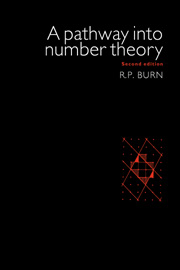Book contents
- Frontmatter
- Contents
- Preface to the second edition
- Introduction
- 1 The fundamental theorem of arithmetic
- 2 Modular addition and Euler's ɸ function
- 3 Modular multiplication
- 4 Quadratic residues
- 5 The equation xn + yn = zn, for n = 2, 3, 4
- 6 Sums of squares
- 7 Partitions
- 8 Quadratic forms
- 9 Geometry of numbers
- 10 Continued fractions
- 11 Approximation of irrationals by rationals
- Bibliography
- Index
- Frontmatter
- Contents
- Preface to the second edition
- Introduction
- 1 The fundamental theorem of arithmetic
- 2 Modular addition and Euler's ɸ function
- 3 Modular multiplication
- 4 Quadratic residues
- 5 The equation xn + yn = zn, for n = 2, 3, 4
- 6 Sums of squares
- 7 Partitions
- 8 Quadratic forms
- 9 Geometry of numbers
- 10 Continued fractions
- 11 Approximation of irrationals by rationals
- Bibliography
- Index
Summary
A pocket calculator is needed for this and the following chapter.
Irrational square roots
1 If a and b are positive real numbers and a/b = √2, prove that (2b -a)/(a-b) = √2 and that b > a-b > 0. Use Fermat's method of descent to prove that a and b cannot both be integers.
2 If a and b are positive real numbers and a/b =√7, prove that (7b-2a)/(a-2b) = √7 and that b>a-2b>0. Deduce that a and b cannot both be integers.
3 Construct a proof, similar to the ones you have used in q 1 and q 2, which establishes that √57 is not a rational number.
4 Find integers a, b, c, d such that 2520/735 = 2a3b5c7d.
5 If p1 p2, P3,… is the sequence of distinct prime numbers, explain why every non-zero rational number can be expressed in the form for some n and uniquely defined integers a, a2, …, an.
6 If what can be said about the indices for r2?
7 Can 2, 3, 5 or 6 be the square of a rational number?
Convergence
The notion of a continued fraction emerges from an attempt to find rational approximations to irrational square roots.
8 Prove that, and deduce that
9 The five numbers
are also conventionally exhibited in the form
and in the form
[1], [1,2], [1,2,2], [1,2,2,2], [1,2,2,2,2].
(i) Express each of these five numbers as a quotient of integers.
(ii) If a/b and c/d are adjacent terms in (i), find ad-be for the four possible cases.
(iii) Use a calculator to express these five numbers in decimal form, and notice whether the sequence increases, decreases or oscillates, and whether it appears to approach √2.
10 For real numbers a1, a2, a3,…, an, the simple continued fraction is denoted by [a1, a2, a3, …, an]. Convention demands that a, when ai≥2 .
- Type
- Chapter
- Information
- A Pathway Into Number Theory , pp. 214 - 241Publisher: Cambridge University PressPrint publication year: 1996



